This was published 8 years ago
Berlin city tour, Germany: A walk through Berlin's wild, wild West
By Kerry van der Jagt
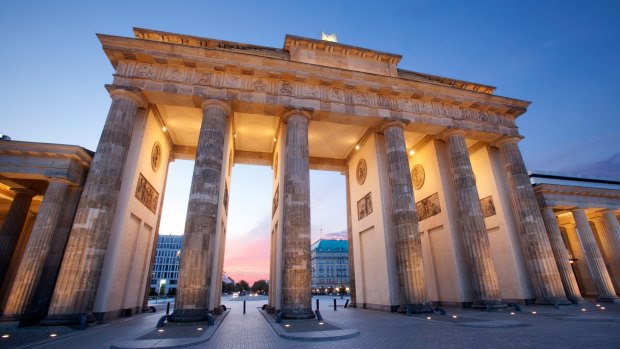
The Brandenburg Gate in Berlin.
Of all the reminders of Nazi Germany I expected to find in Berlin, an uneven cobblestone was not one of them. Yet here I am, rubbing my stubbed toe with one hand and wiping away tears with the other. Not from the pain, but from the sad story behind Berlin's "stumbling stones". "Each brick is a mini-memorial to one individual who died at the hands of the Nazis," says my guide, Heri von Reiche, pointing to the cobblestone-sized, brass brick embedded in the pavement. "They've been placed in front of the homes where the person once lived."
This particular brick commemorates Max Drucker, the inscription detailing his birthdate, deportation date, and the date and place he was killed. The one beside is for his wife. "The installations were started by an artist in the mid-90s," von Reiche says. "Today we have more than 5000 across the city."
Without von Reiche's guidance I wouldn't have noticed them, or the Hotel Adlon Kempinski where Marlene Dietrich enjoyed a drink, or learnt the story about Berlin's "rubble women", who, after the Allied bombings of World War II, arose from the rubble and cleared away the mess brick by brick.
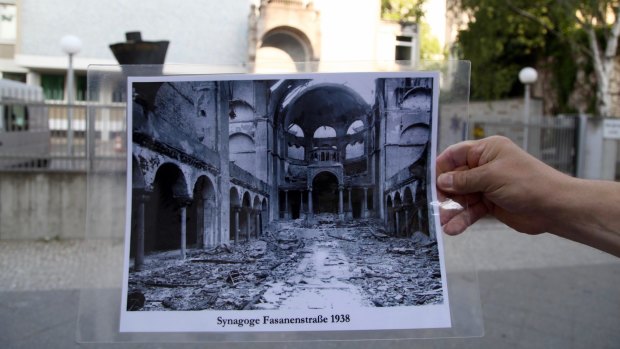
A photograph showing the burned interior of Synagogue Fasanenstrasse.Credit: Kerry van der Jagt
Such insights are the reasons for joining a walking tour like Context Travel's The Pendulum Swings; A journey through West Berlin. In a city known for its "alternative" tours, of underground bunkers and urban art, this three-hour tour with a local cultural expert shows another side of modern Berlin.
The tour focuses on Charlottenburg, an area overlooked by tourists in recent years, but poised to become an alternative cultural centre to the more bohemian eastern districts. "After the wall came down in 1989 the East was flooded by people looking for an exotic lifestyle," von Reiche says. "But as the former East becomes more gentrified the creatives are moving back to where it all began."
Berlin's heydays were the Golden Twenties, when the city was one of the world's great cultural capitals, equally famous for its contribution to literature and science as its plays and parties. "Hemingway and Twain visited, Marlene Dietrich made films and there was a cabaret on every corner," von Reiche says.
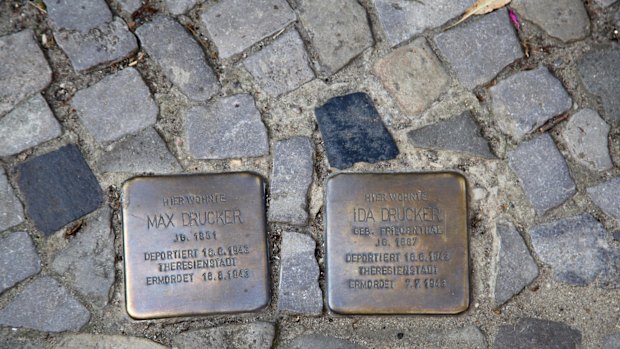
Stumbling stones in the pavement of Charlottenburg.Credit: Kerry van der Jagt
While he points out the luxury stores along Kurfurstendamm Boulevard, the Champs-Elysees-like thoroughfare which is blooming again, he also makes time for the small things – memorials to the forgotten victims of the Third Reich – gypsies, political enemies and homosexuals, a plaque marking the home of Jewish poet Mascha Kaleko, and a before and after photograph of the Synagogue Fasanenstrasse, smashed and burned in 1938.
Von Reiche, who was four when the wall went up in 1961, walks slowly, crafting his own route and sharing anecdotes along the way. We hear about the relative who still refuses to cross to the East, the neighbourhood concept of Kiez and how, after 28 years of guiding, he still learns something everyday.
His neighbourhood is now flush with new hotels such as the Waldorf Astoria, Hotel Zoo and 25hours Hotel Bikini Berlin, an edgy hotel housed in the Bikini Berlin. Redeveloped in 2014, the industrial-chic "bikinihaus", a prison-like, post-war monstrosity, is home to pop-up fashion stores, farm-to-table dining, design shops, hotel and rooftop bar.
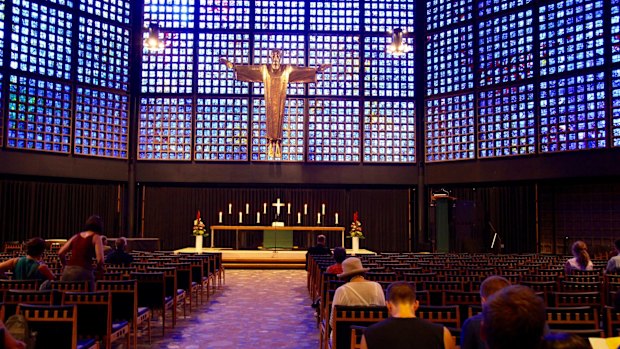
The Kaiser Wilhelm Memorial Church.Credit: Kerry van der Jagt
"As a result of this development there's been a cultural spill-over to the surrounding streets," von Reiche says, pointing out Amerika Haus, a post-war institution now a gallery, the Helmut Newton Foundation Museum and Literaturhaus (House of Literature) with its ever-increasing program of readings, lectures and exhibitions.
Our final stop is the wrecked shell of the Kaiser Wilhelm Memorial Church, one of Berlin's best-known landmarks. "Come this way," von Reiche says, leading me away from the hull and into the octagonal building next door.
I step inside and everything bleeds blue, the glow from 20,000 stained glass bricks illuminating the cavern like an aquarium. As I take my seat inside the "new" Kaiser Wilhelm Memorial Church (built in 1961) the congregation begins to sing, my eyes filling with tears for the second time that day, the universal message of love and hope uplifting in any language. "6pm every Tuesday," whispers von Reiche. Once again, it helps to have a local on hand.
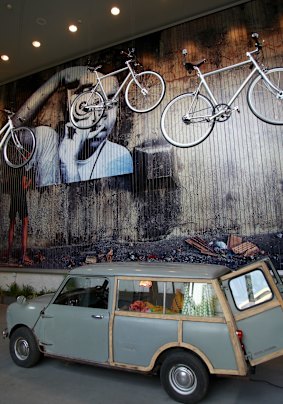
Hotels with edge: Entrance foyer of the 25hour Hotel Bikini Berlin.Credit: Kerry van der Jagt
TRIP NOTES
MORE INFORMATION
GETTING THERE
Cathay Pacific operates several flights a day from Sydney and Melbourne, via Hong Kong, to London and other European gateways, with codeshare to Berlin. See cathaypacific.com.au.
STAYING THERE
Full of historic character, Hotel Zoo is on the Kurfurstendamm in Charlottenburg. Superior rooms start from $283 a night. See hotelzoo.de.
TOURING THERE
Context Travel offers small group tours (maximum six people) led by local experts and scholars for "culturally curious" travellers. The Pendulum Swings tour costs $127 a person. See contexttravel.com.
Kerry van der Jagt was a guest of visitBerlin.
Sign up for the Traveller Deals newsletter
Get exclusive travel deals delivered straight to your inbox. Sign up now.